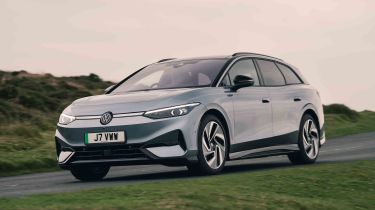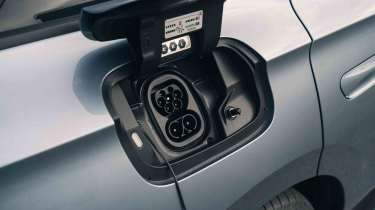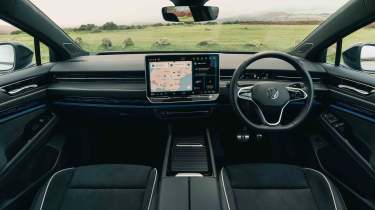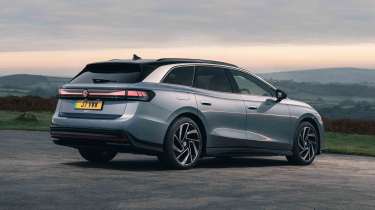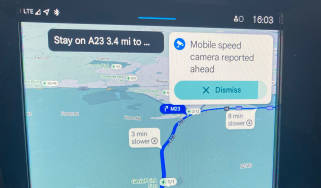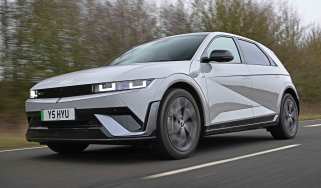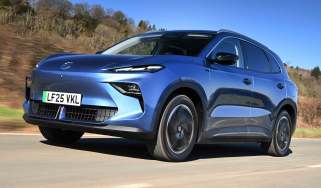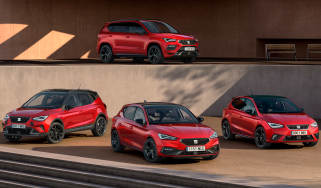Volkswagen ID.7 Tourer
The Volkswagen ID.7 Tourer is a highly practical electric estate that majors on refinement and comfort

Is the Volkswagen ID.7 Tourer a good car?
While the price of the Volkswagen ID.7 Tourer may be a bit steep, it's hard to argue against it considering how well it performs in most areas. In terms of practicality, it trumps all other electric estate rivals (and some traditionally powered load-luggers, too), while it also has the measure of the best in the class for refinement and comfort. For those looking for an EV that covers all bases, the ID.7 Tourer could be just what they’ve been waiting for.
|
Key specs | |
|
Fuel type |
Electric |
|
Body style |
Estate |
|
Powertrain |
77kWh (useable) battery, 1x e-motor (Pro Match) rear-wheel drive |
|
Safety |
5-Star Euro NCAP (2023) |
|
Warranty |
3yrs/60,000 miles |
How much does the Volkswagen ID.7 Tourer cost?
While the ID.7 Tourer wears the badge of the people’s car, it certainly isn’t an inexpensive choice, because prices start at more than £52,000 for the 77kWh Pro version, while the long-range 86kWh Pro S comes in at over £56,000. The four-wheel-drive GTX, meanwhile, is nearly £63,000.
The regular ID.7 hatchback is already a fine family car, but its Tourer estate sibling provides additional practicality, and is far more aerodynamically efficient than an SUV. This benefits the range, without having to resort to greater battery capacity.
There’s a choice of rear-wheel drive or four-wheel drive with the ID.7 Tourer. The rear-wheel-drive models use a single motor producing 282bhp, while the four-wheel-drive GTX has a dual-motor set-up producing 335bhp. A 77kWh battery is fitted to Pro models, while the longer-range Pro S and GTX use the bigger 86kWh battery.
Every single-motor Pro and Pro S ID.7 Tourer comes in well equipped Match trim, featuring matrix-LED headlights, 19-inch wheels, three-zone climate control, wireless Apple CarPlay and Android Auto, a 15-inch infotainment system and an augmented-reality head-up display. Four-wheel-drive GTX models feature unique 20-inch alloy wheels, an upgraded Harman Kardon sound system, ventilated front seats, adaptive suspension and sportier exterior styling.
Electric motor, performance & drive
Given that the ID.7 Tourer is designed to cover long distances, you’ll be pleased to find it can also happily cope with town driving. Even taking into account its not inconsiderable length of nearly five metres, the ID.7 Tourer is quite easy to pilot at low speeds, with smooth brakes, light steering and a responsive accelerator making it easy to go along with the flow of traffic, without subjecting passengers to a jerky ride.
Hit a fast A-road or B-road, and the ID.7 Tourer is less happy. It’s perfectly competent and the 282bhp of the rear-wheel-drive versions provides a highly respectable 0-62mph time of 6.7 seconds in Pro S models (this falls to 6.6 seconds in the lighter Pro and 5.5 seconds in GTX form). But every version weighs over 2,100kg, which blunts the feeling of acceleration and hurts its agility.
Even in Sport mode, the ID.7 Tourer never feels entertaining to drive. It leans in bends and lacks the sharpness of sportier rivals, with numb steering and a chassis that’s reined in by an ever-present stability control system that cuts in early to stop any histrionics. Even the brakes feel a bit soft and have a long pedal travel, which robs you of a little confidence when trying to slow down this heavy car from higher speeds.
The ID.7 Tourer feels most at home on the motorway, with a level of serenity that some far pricier luxury cars struggle to manage, thanks to little in the way of road and wind noise. Choose the optional Exterior Plus Pack, and you’ll gain adaptive suspension, which does a great job of isolating you from the worst bumps and scruffy road surfaces at speed, allowing you to waft along without any underlying fidgeting. This is quite an achievement, given the huge optional 20-inch wheels our test car came with.
|
Model |
Power |
0-62mph |
Top speed |
|
ID.7 Pro Match |
282bhp |
6.6 secs |
112mph |
|
ID.7 Pro S Match |
282bhp |
6.7 secs |
112mph |
|
ID.7 4Motion GTX |
355bhp |
5.5 secs |
112mph |
Range, charging & running costs
Despite the Pro version having the smaller 77kWh battery, its claimed 373 miles of range beats the 342-mile BMW i5 Touring, while the Pro S and GTX use a bigger 86kWh battery, giving a whopping 424 miles in the former and 359 miles for the latter.
We tried a 86kWh Pro S battery in mild temperatures on a mixture of fast A-roads and B-roads with some motorway driving, returning a figure of 3.3mi/kWh. This works out to around 284 miles of range, which is a little disappointing, but the car tested didn’t have a heat pump fitted, so this has to be taken into account. It’s a shame that a heat pump is still an option, especially when there are many cheaper EVs that come with one as standard.
The 77kWh battery has a maximum charging speed of 175kWs, while the 86kWh ramps that up to 200kWs, so a 10 to 80 per cent charging window means top-up times using a suitably rapid charger take 28 minutes and 26 minutes, respectively. Utilising a more cost-effective 7kW home wallbox charger, it’ll take just over 12 hours to fully recharge the 77kWh battery, while the 86kWh takes just under 14 hours.
Company car drivers will benefit from lower Benefit-in-Kind (BiK) tax rates compared with traditional petrol, diesel or even hybrid-powered cars such as the Volkswagen Passat, because of the lack of tailpipe emissions. EVs also benefit from not having to pay road tax or the London Congestion Charge, at least until 2025.
In terms of insurance, both the Pro and Pro S versions of the ID.7 Tourer are in group 38, while the GTX is in group 41, making it the most expensive model in the range to provide cover for.
According to our experts, the ID.7 Tourer is expected to retain between 50 to 52 per cent of its original value over three years or 36,000 miles. The BMW i5 Touring does slightly better here, at 52 to 54 per cent, but it is costlier to buy in the first place.
To get an accurate valuation for a specific model, check out our valuation tool...
|
Model |
Battery size |
Range |
Insurance group |
|
ID.7 Tourer Pro 77kWh |
77kWh |
373 miles |
38E |
|
ID.7 Tourer Pro S 86kWh |
86kWh |
424 miles |
38E |
|
ID.7 Tourer GTX 86kWh |
86kWh |
359 miles |
41E |
Design, interior & technology
The ID.7 Tourer features a streamlined and aerodynamic design in order to maximise the electric range. Indeed, this Volkswagen has a slippery drag coefficient of 0.25, although the BMW i5 Touring is even more impressive here, with a rating of 0.23.
Inside, the ID.7 Tourer has a much more premium feel when compared with earlier ID models, but it isn’t a particularly colourful environment – you’ll have to utilise the standard 30-colour interior ambient lighting system to make things brighter.
You’ll also need to get used to some quirks of the main controls, in particular the positioning of all the wiper controls on the left to make room for the gear selector on the right. You will get accustomed to them over time, but it’s something to be aware of if you come to the ID.7 Tourer from an older Volkswagen model or another brand.
It’s a shame that you can no longer adjust the direction of the air flow from the central vent without having to dive into the main infotainment system. This is far more distracting than just having manual controls, which most people have been used to in cars for decades.
The ID.7 Tourer uses plusher materials throughout the interior than we have seen in previous ID cars, and generally has a more premium feel. It isn’t quite up to the level of the i5 Touring, but is certainly a step ahead of other electric estates, such as the Peugeot E-308 SW or Vauxhall Astra Electric Estate.
Sat-nav, stereo and infotainment
All versions of the ID.7 Tourer use the same large 15-inch central touchscreen, which features a bright display with impressive response times to inputs. There are still some controls that are hidden a little too deeply within sub-menus, but you can save a number of frequently used functions to the main screen to make things easier to find.
Also, having such a large screen means that the climate controls are on permanent display at the bottom. This means that you don’t have to come out of the screen you’re on (whether it’s the sat-nav or for the DAB radio) in order to adjust the temperature.
Complementing the standard wireless Apple CarPlay and Android Auto smartphone connectivity is a wireless phone charging pad, which is under a sliding roller cover ahead of the cup-holders. A nine-speaker audio system is standard, but it can be upgraded to a 12-speaker, 700-watt Harman Kardon sound system if you choose the expensive £2,000 Interior Pack.
Boot space, comfort & practicality
An estate needs to be practical, so it’s pleasing to see that the ID.7 Tourer affords a six-foot driver and equally tall passenger plenty of room to get settled in. Visibility is also pretty good, with reasonably slim pillars and a decent-sized back window helping to avoid any large blindspots while reversing into a parking space.
Similarly lanky passengers in the back will have no issues with the amount of headroom, legroom and shoulder room on offer. There’s a flat floor, meaning the middle-seat occupant doesn’t have to play footsie with those sitting beside them, and parents will like that the rear doors open wide, making it easy to fit a child seat. A pair of Isofix child seat mounting points are conveniently hidden behind some removable plastic covers on the outer positions of the rear seats, and there’s another Isofix point on the front passenger seat.
The 605-litre ID.7 Tourer surpasses the i5 Touring for luggage capacity, and provides space to store its Type 2 charging cable in a cubby below the boot carpet. A standard adjustable height floor keeps the boot area level with the bumper, and creates a reasonably flat loading area of 1,948 litres when the standard 60:40 split rear seats are folded.
As a towing vehicle, the ID.7 Tourer isn’t the most obvious choice, based on raw figures alone. The regular Pro S version only has a 1,000kg braked towing capacity, while the four-wheel-drive GTX increases this to 1,200kg. If you want more capacity and still need some electrified driving, the plug-in eHybrid versions of the Volkswagen Tiguan and Volkswagen Passat can both handle a 1,800 kg caravan or trailer.
|
Dimensions | |
|
Length |
4,961mm |
|
Width |
1,862mm (2,141mm inc. mirrors) |
|
Height |
1,551mm (1,549mm GTX) |
|
Number of seats |
5 |
|
Boot space |
605-1,948 litres |
Safety & reliability
It’s too soon to say what owning an ID.7 Tourer will be like, because the car is too new to have featured in our most recent Driver Power owner satisfaction survey. The rather disappointing 29th position out of 32 manufacturers for the Volkswagen brand in our 2024 poll puts it slightly ahead of Ford in 30th, but some way behind BMW in 14th.
The ID.7 Tourer will be a safe space for your family, because it received the maximum five-star rating from Euro NCAP in 2023, beating the score of the BMW 5 Series (which also covers the electric i5 version) in the adult and child occupant categories. The VW only came up a little short of the BMW in the vulnerable road user and safety assistance disciplines.
All versions of ID.7 Tourer feature autonomous emergency braking (AEB) to help mitigate or prevent low-speed collisions with other vehicles, cyclists and pedestrians. There’s also adaptive cruise control to keep a safe distance from the vehicle in front, as well as lane-keep assistance to help maintain positioning within the lane.
A blind-spot monitoring system is also standard, and provides a warning of vehicles that are alongside you when indicating to change lanes. When parked up, it’ll also provide a warning of approaching vehicles to hopefully prevent you from opening a door into the path of a cyclist. There’s also a rear cross traffic alert system designed to stop drivers from reversing out into the path of an approaching car.
Volkswagen has a fairly standard three-year/60,000-mile warranty, which can’t quite match the unlimited mileage policy provided by BMW. The battery pack comes with a separate eight-year/100,000-mile warranty, which guarantees that the battery pack will retain above 70 per cent of its capacity over that period, or it’ll be replaced under warranty.
Those covering high mileages will appreciate the fact that service intervals are every two years, and you can cover an unlimited number of miles during that time. A service plan can be set up at the time of purchase for a lump sum of £372, or £15.50 per month over 24 months.
|
Key standard safety features |
Euro NCAP safety ratings |
|
Volkswagen ID.7 Tourer alternatives
The ID.7 Tourer is positioned above smaller electric estates such as the Peugeot E-308 SW and Vauxhall Astra Electric Sports Tourer, and provides a much bigger boot. The ID.7 Tourer also delivers the long-range driving comfort of a BMW i5 Touring, but without the latter’s premium pricing.
In terms of where the ID.7 Tourer sits in the Volkswagen range, it costs less than the Volkswagen ID.Buzz, but more than the ID.4 and ID.5 electric SUVs. The ID.Buzz would be better for those that have bigger families, especially now that it can be had with seven seats. However, the ID.7 Tourer has much greater range thanks to its superior aerodynamics and reduced weight.
Frequently Asked Questions
Volkswagen states that its ID line-up of electric cars only requires servicing every two years, with no specified mileage limits.

